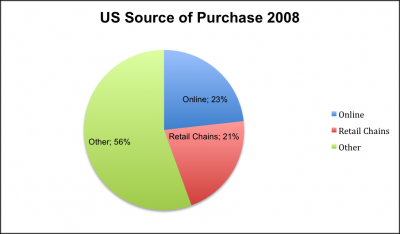The iPad launched in Canada two weeks ago now and we’re waiting to see what impact it will have on book sales and the publishing industry as a whole. While it’s still too early to get concrete data (in Canada few books have even been licensed to the iBookstore) some early stats are exciting. Wired magazine released the numbers for their iPad app, stating that they sold 24,000 copies of the app within the first 24 hours it was available. At $5 per app, this means that Wired earned $120,000 for their app in just one day.
On the book front, according to Stephen Windwalker, ebooks represented 30% of all first week sales for Steig Larsson’s The Girl Who Kicked the Hornets Nest. He states:
By comparison, published reports of the total ebook sell-through for Dan Brown’s The Lost Symbol last year put it at less than 10 percent of the title’s overall sales, despite the fact that ebook sales outperformed hardcover sales on the Amazon.com website for several weeks.
While it’s very possible that these numbers simply represent early excitement over a new technology, they do show the initial impact that the iPad is having on industry sales. While it’s still too early to tell what realistic sales numbers will look like, statistics show that reading and book buying behaviours have been changing for the last few years.
Here are some of the changes over the last 5 years to how the internet has affected book discovery and sales.
Source of Book Purchases
Taking data from Turner-Riggs’ The Book Retail Sector in Canada, Charlotte Abbott’s post The New Book Buying Realities, and InsideBookPublishing.com’s post Book Market in 2009 (which refers to BookSeller.com numbers), we see these changes in book buying behaviours:
Note: According to The New Book Buying Realities these numbers flipped in 2008. In 2007, retail sales represented 23%.
In addition to the above statistics, according to The Book Retail Sector in Canada:
In 2005, Canadian interest in online book purchases was increasing. 1 in 5 (21%) buyers said they were interested in making an online book purchase in the near future versus 14% in 2002.
During this time, Chapters.ca was growing. Chapters.ca represented 5% of total revenue in 2002 to 15% in 2007. While the report states that Amazon does not report its Canadian sales publicly, they did say that Amazon.ca sales doubled from 2002 to 2007.
In The New Book Buying Realities, Charlotte Abbott lists some US stats:
How US Consumers Became Aware of Books in 2008
- 67% see reviews online vs. in traditional print media
- 54.8% see online ads to find books
- 24.8% use retailer emails (i.e. subscription newsletters from Amazon)
- 15.7% see ads in newspapers and magazines
- Out of purchases based on online awareness, online book reviews were the main source of information at 29%
- Ebook sales grew 125% overall in 2008
While some of these numbers are a little out of date and we’re not comparing apples to apples here, generally we can take a few things from them:
- It’s clear that book buying habits are moving more and more online. From 2002 to 2008 there’s been a substantial shift in where people buy books. The growth of Chapters.ca and Amazon.ca confirms this.
- Online reviews are important. Publishers should be focusing their marketing efforts on getting online attention for their books.
- Online ads are also important. Publishers should be using their ad budgets for online ads rather than print.
- Retailer emails help to sell books. This is because they make things easy with direct links to book reviews and product pages to buy the books. Publishers should be following their lead and replicating these best practice in their own emails.
Does your own experience coincide with these numbers? Does anyone have any recent numbers that they can share? Or a report that shows different statistics?



